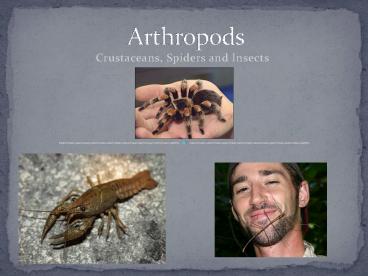Crustaceans, Spiders and Insects - PowerPoint PPT Presentation
1 / 10
Title:
Crustaceans, Spiders and Insects
Description:
Crustaceans, Spiders and Insects Arthropods are the most successful phylum on the planet! 750,000 species Arthropods have Segmented body Tough exoskeleton Jointed ... – PowerPoint PPT presentation
Number of Views:242
Avg rating:3.0/5.0
Title: Crustaceans, Spiders and Insects
1
Arthropods
- Crustaceans, Spiders and Insects
2
What is an Arthropod?
- Arthropods are the most successful phylum on the
planet! - 750,000 species
- Arthropods have
- Segmented body
- Tough exoskeleton
- Jointed appendages
3
Form and Function
- Feeding complex mouthparts to eat a wide range
of food - Respiration
- Land air enters through spiracles holes in
the side of the body. - Water gills or book gills
- Circulation open circulatory system open
sinuses - Excretion Malpighian tubules saclike organ
that combines urine and waste together - Response have a brain! Sophisticated eyes and
taste receptors - Movement have musclescan flex and extend
- Reproduction internal or external reproduction
depending on the species
4
Groups of Arthropods
- Crustaceans primarily aquatic
- Examples crabs, shrimps,
- crayfishes and pillbugs.
- Characteristics
- Two pairs of antennae
- 2 or 3 body sections Cephalothorax/Abdomen
- Chewing mouthparts called mandibles
5
Growth and Development
- Molting when arthropods outgrow their
exoskeleton - Steps to molting
- 1. skin glands digest inner part of exoskeleton
- 2. other glands create a new exoskeleton
- 3. animal pulls itself out of old skeleton
- 4. While new skeleton is soft animal fills it
with air to allow for growth
6
Groups of Arthropods
- 2. Spiders and their relatives
- Characteristics
- No antennae
- Cephalothorax and abdomen
- 2 pairs of mouthpart appendages
- Chelicerae fangs to stab and paralyze prey
- Pedipalps grab prey
- Spiders are in the class Arachnida
- Spiders have no jaws so they liquify their prey
- Scorpions are found in warm climates.
- The abdomen has a stinger that can kill
- and paralyze prey.
7
Groups of Arthropods
- 3. Insects
- There are 3 classes of Insects
- 1. Chilopoda centipedes
- 2. Diplopoda millipedes
- 3. Insecta the insects
- Centipedes
- each body segment has one pair of legs
- carnivores
- live beneath rocks or in the soil
- 2. Millipedes each body segment has two pairs
of legs
- Dragon Millipede produces cyanide when
threatened.
8
Insects, Contd.
- Insects have a body divided into three parts
- Head antennae and eyes
- Thorax - three pairs of legs, wings
- Abdomen stinger or poison gland
9
Insect Reproduction
- Insects undergo metamorphosis a process of
changing shape and form. - Incomplete Metamorphosis Young (called nymphs)
look very much like the adults. - Examples Grasshoppers
10
Insect Reproduction
- 2. Complete metamorphosis dramatic change in
body form. EggsLarvaePupaAdult - Examples bees, moths, beetles, butterflies,
flies































